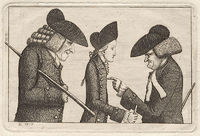Annotation:Miss Burnet's Reel: Difference between revisions
m (Text replacement - "garamond, serif" to "sans-serif") |
No edit summary |
||
| Line 1: | Line 1: | ||
---------- | |||
---- | {{TuneAnnotation | ||
|f_tune_annotation_title= https://tunearch.org/wiki/Annotation:Miss_Burnet's_Reel > | |||
'''MISS BURNET'S REEL.''' AKA and see "[[Miss Jane Stewart (1)]]," "[[Miss Jane Stewart's Strathspey--Pittyvaich (1)]]," "[[Miss Jane Campbell's Strathspey]]," "[[Johnny Pringle]]" {Gow's title}. Scottish, Strathspey. G Major. Standard tuning (fiddle). AAB. Composed by William Marshall (1748-1833) and first published in an attachment (c. 1788) to his 1781 '''First Collection'''. In 1822 Marshall included it in his 1822 collection under the title "[[Miss Jane Stewart's Pittyvaich]]." The strathspey was called "[[Johnny Pringle]]" by Gow when he published it in his '''Repository, Part Third''' (1806), undoubtedly in honor of fiddler-composer John Pringle who had published the melody in 1801 under the title "[[Miss Jane Campbell's Strathspey]]." Alburger points out that the octave slur in the first measure forces movement to the third position to accomplish. | |f_annotation='''MISS BURNET'S REEL.''' AKA and see "[[Miss Jane Stewart (1)]]," "[[Miss Jane Stewart's Strathspey--Pittyvaich (1)]]," "[[Miss Jane Campbell's Strathspey]]," "[[Johnny Pringle]]" {Gow's title}. Scottish, Strathspey. G Major. Standard tuning (fiddle). AAB. Composed by William Marshall (1748-1833) and first published in an attachment (c. 1788) to his 1781 '''First Collection'''. In 1822 Marshall included it in his 1822 collection under the title "[[Miss Jane Stewart's Pittyvaich]]." The strathspey was called "[[Johnny Pringle]]" by Gow when he published it in his '''Repository, Part Third''' (1806), undoubtedly in honor of fiddler-composer John Pringle who had published the melody in 1801 under the title "[[Miss Jane Campbell's Strathspey]]." Alburger points out that the octave slur in the first measure forces movement to the third position to accomplish. | ||
<br> | <br> | ||
<br> | <br> | ||
Miss Burnet was the daughter of James Burnet (1714-1799), Lord Monboddo, and tragically died in “the bloom of her youth”, although not before being immortalized by being included among the subjects of several 18th century paintings. Her father, the Lord, was a man of letters and at the center of Edinburgh intelligencia of the time; he postulated a theory of the origin of the species prior to Darwin (Cowie, '''The Life and Times of William Marshall''', 1999). He was recognized in his day as "learned but eccentric" and his "theory that the human race was originally 'gifted with tails' was the subject of so many jokes." See also Robert Mackintosh's "[[Miss Burnet of Monboddo]]." | Miss Burnet was the daughter of James Burnet (1714-1799), Lord Monboddo, and tragically died in “the bloom of her youth”, although not before being immortalized by being included among the subjects of several 18th century paintings. Her father, the Lord, was a man of letters and at the center of Edinburgh intelligencia of the time; he postulated a theory of the origin of the species prior to Darwin (Cowie, '''The Life and Times of William Marshall''', 1999). He was recognized in his day as "learned but eccentric" and his "theory that the human race was originally 'gifted with tails' was the subject of so many jokes." See also Robert Mackintosh's "[[Miss Burnet of Monboddo]]." | ||
[[File:monboddo.jpg|200px|thumb|left|Henry Home, Lord Kames; Hugo Arnot; James Burnett, Lord Monboddo, by John Kay (died 1826)]] | [[File:monboddo.jpg|200px|thumb|left|Henry Home, Lord Kames; Hugo Arnot; James Burnett, Lord Monboddo, by John Kay (died 1826)]] | ||
|f_source_for_notated_version= | |||
|f_printed_sources=Alburger ('''Scottish Fiddlers and Their Music'''), 1983; Ex. 58, p. 86 ('A' part only). | |||
|f_recorded_sources= | |||
|f_see_also_listing= | |||
}} | |||
Revision as of 06:55, 6 April 2023
X:1 T:Miss Burnet's Reel M:C L:1/8 R:Strathspey K:G (D<G) (G>g) d<GTB2|D<GG<g d<GB<g|(D<G) (G>g) d>G TB2|(c>A)TB>G TA>GE<A:|
MISS BURNET'S REEL. AKA and see "Miss Jane Stewart (1)," "Miss Jane Stewart's Strathspey--Pittyvaich (1)," "Miss Jane Campbell's Strathspey," "Johnny Pringle" {Gow's title}. Scottish, Strathspey. G Major. Standard tuning (fiddle). AAB. Composed by William Marshall (1748-1833) and first published in an attachment (c. 1788) to his 1781 First Collection. In 1822 Marshall included it in his 1822 collection under the title "Miss Jane Stewart's Pittyvaich." The strathspey was called "Johnny Pringle" by Gow when he published it in his Repository, Part Third (1806), undoubtedly in honor of fiddler-composer John Pringle who had published the melody in 1801 under the title "Miss Jane Campbell's Strathspey." Alburger points out that the octave slur in the first measure forces movement to the third position to accomplish.
Miss Burnet was the daughter of James Burnet (1714-1799), Lord Monboddo, and tragically died in “the bloom of her youth”, although not before being immortalized by being included among the subjects of several 18th century paintings. Her father, the Lord, was a man of letters and at the center of Edinburgh intelligencia of the time; he postulated a theory of the origin of the species prior to Darwin (Cowie, The Life and Times of William Marshall, 1999). He was recognized in his day as "learned but eccentric" and his "theory that the human race was originally 'gifted with tails' was the subject of so many jokes." See also Robert Mackintosh's "Miss Burnet of Monboddo."


